Five decades of anything is generally a great excuse for a celebration. Birthdays, weddings, 50 years in a job – any golden anniversary like that deserves some recognition.
And this year, it’s Kawasaki’s turn. Because 2022 is the fiftieth anniversary of the very first of its ‘Z’ bikes, the Z1. It was back in 1972 that the Akashi firm released the 903cc four-cylinder superbike, and over the following years, it’s made the letter its own in the two-wheeled world.
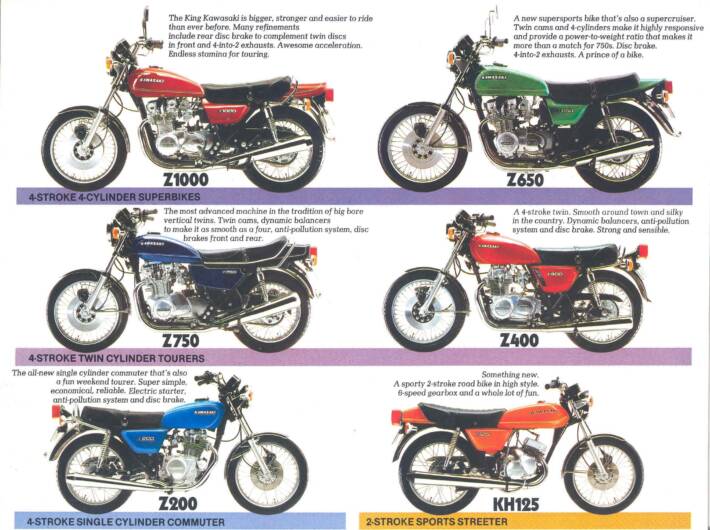
The original Zeds were all air-cooled machines, with the Z1 soon joined by 1000, 1100, 750, 650 and 550 four-cylinder models. Singles and twins appeared too: from the tiny Z200 single up to the beefy Z750 parallel twin. Turbochargers were briefly in fashion, on the Z1-R TC and Z750 Turbo models, and the late 1970s saw some sort of ultimate, when the Z1300 water-cooled inline-six was released – a true monster on two wheels.
In the early 1980s, the Z became a GPz, then GPZ, the capital Z marking the water-cooled engines of the GPZ900R and GPZ600, before Kawasaki’s models moved on to more ZX-y names. The 1980s and 90s saw the ZXR750, ZX-7R, ZX-9R supersports bikes and the ZZ-R600 and 1100 super tourers all appear with superlative performance and styling.
To celebrate 50 years of the Z, Kawasaki Europe took us to a special event in Switzerland, where the Swiss/Liechtenstein importer has a fantastic museum. It’s filled with immaculate zero-mile models from the firm’s line up, dating from the late 1960s, right up to the modern day. We were taken through the most important models, with never-before-seen details of the original Z1 launch in Japan, as well as fantastic archive materials from the 1970s and 80s.
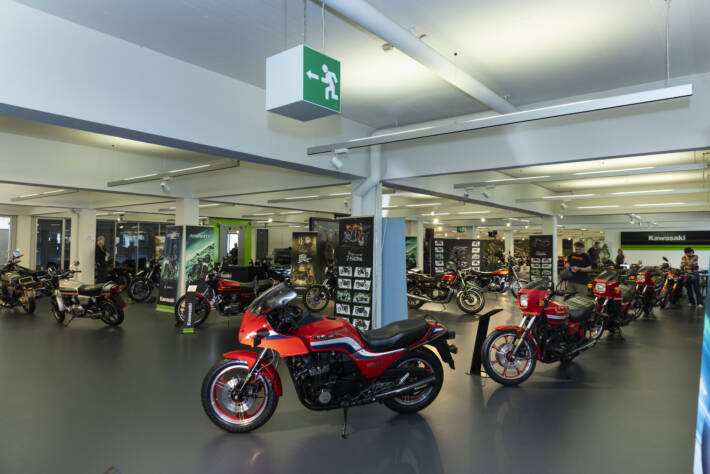
Here, then, is our pick of the very best Kawasaki Z models, from the 1972 Z1, up to the GPz models of the early 1980s. Most of them were class-topping machines in their day, and all of them make great classic rides today, whether in standard/restored or upgraded form.
1 Z1/Z900
The Z1 marked Kawasaki out as a firm destined for great things. Its big-bore two-stroke bikes of the late 1960s were good-looking bikes, if a little fast and loose. But pollution, reliability and fuel consumption counted against them, and they were reaching their limits in terms of development. A large-capacity four-stroke engine would be a better option, especially in the vital American market, where Kawasaki was focusing its efforts.
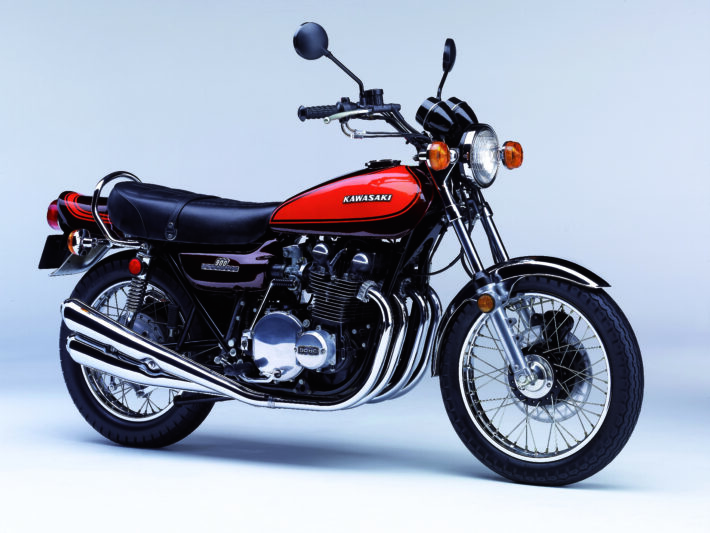
Kawasaki America had proposed a solution in 1968: a 750cc inline-four powerplant, in a conventional chassis design, not dissimilar to that on the big two-strokes. Code-named ‘Zapper’, the new 750cc four was well under way in 1969, when disaster struck: Honda had released its revolutionary CB750 superbike. Suddenly, Kawasaki’s 750 four was rendered moot – and the Akashi engineers went back to the drawing board.
The result was dubbed ‘New York Steak’. A mighty 903cc DOHC air-cooled eight-valve engine, putting out 82bhp, in a reinforced cradle-type frame, with conventional suspension, disc brakes and sleek styling lines. Dry weight was around 230kg, and it would top 135mph – incredible performance for the time – while cutting-edge tech like electric start, automatic drive chain oiler and a four-into-four exhaust system wowed an entire generation brought up mostly on prehistoric British twins and singles.
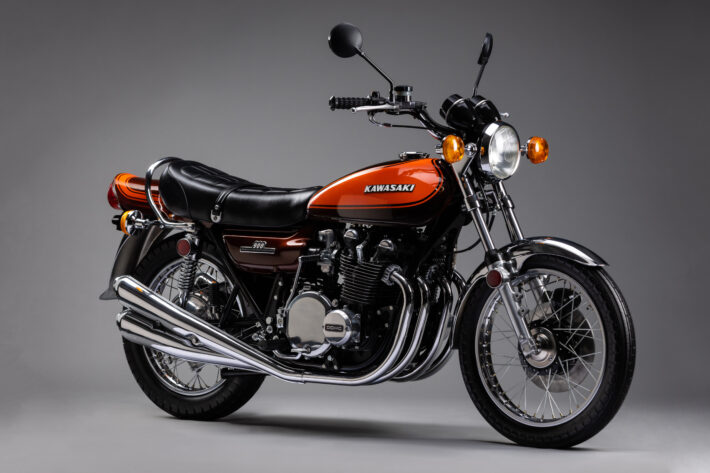
The mighty Z1 out-powered and out-teched the CB750, and would set the stage for a whole range of so-called ‘Universal Japanese Motorcycles’ or UJMs. The double cradle frame, DOHC inline-four engine, naked roadster style and capable running gear would be seen in Suzuki’s GS and Yamaha’s XJ range, with Honda also swapping from a SOHC engine on the original CB750 to DOHC powertrains before experimenting with V-four layouts.
The Z1 itself was a massive success through the first half of the 1970s, in the US and Europe as well as in Japan, where a 750cc version called the Z2 was sold (750cc+ machines were very rare in the home market back then). It was lightly updated in 1975, losing the automatic final drive chain oiler fitted to the original, and renamed the Z900 in 1976, before being replaced by the Z1000 and Z1-R models for 1977.
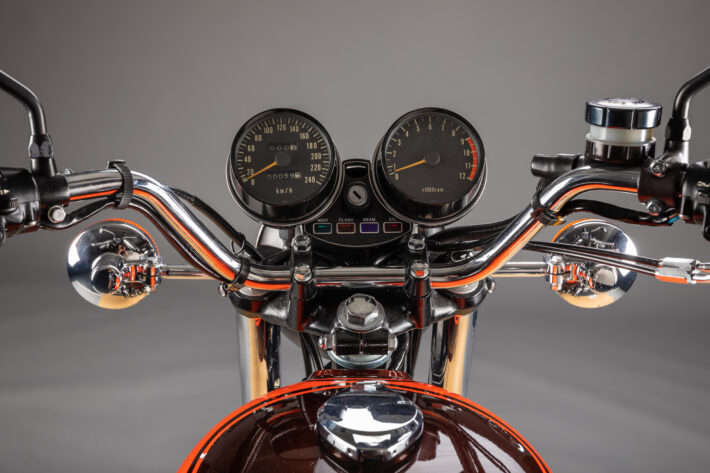
Nowadays, original Z1s are worth serious cash, particularly for unmolested, early production models. But there are still bargains to be had, and a later Z1 B from 1975 in decent or lightly modified condition won’t break the bank. Some light tuning to the under-stressed engine – larger flat-slide carbs, exhaust, perhaps a big-bore kit – will get you easily over 100bhp, and sensible chassis upgrades to shocks, tyres, brakes and forks will also pay dividends.
Put a bit of effort and some cash in, and you can have a 70s-styled bike, with solid 21st century roadster performance. Best of all, bikes older than 40 years are now classed as classics in the UK, with no road tax, MoT test or ULEZ charges to pay…
2 Z1-R and Z1-R Turbo
The 1978 Z1-R is one of those bikes which would still look great if it were launched as a 2022 model. Kawasaki had given it a dash of avant-garde café racer styling, adding a small headlamp fairing, slab-sided tank and restyled sidepanels to the basic Z900 layout. Initially, it was only available in a silver-blue metallic paint scheme, though black and red versions appeared later on.
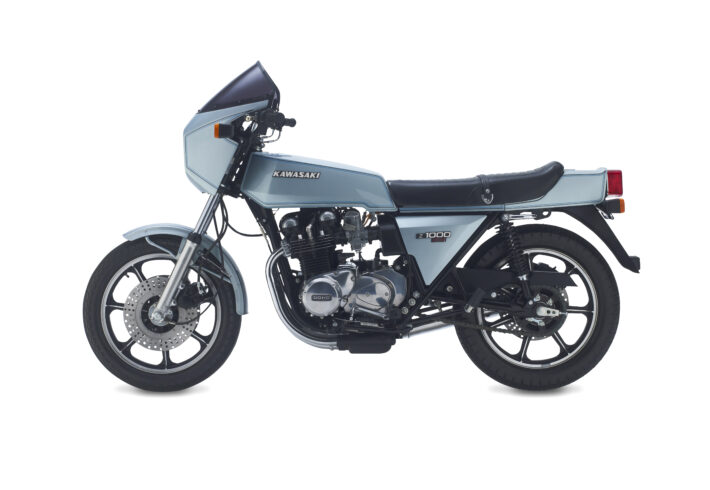
The engine had grown to a 1,015cc capacity in the earlier Z1000 A1, and now made 90bhp in Z1-R form, thanks to bigger 28mm slide carburettors, four-into-one exhaust system, high compression head and other mods. Electric start came as standard – though early models came with an emergency kickstart lever stored under the saddle in case of a flat battery.
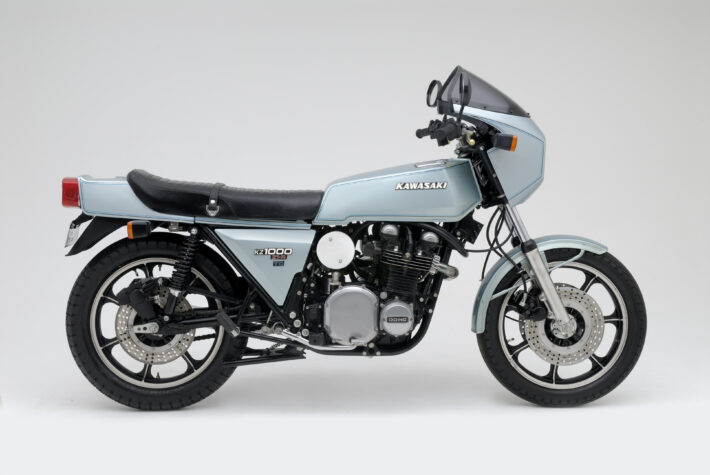
Another oddity was the front brake master cylinder: the headlamp fairing meant it couldn’t bolt onto the handlebars, so it was mounted by the fork leg, and operated by a Bowden cable from the handlebar lever (BMW had used a similar setup on its R90S).
The frame was strengthened by extra gussets welded round the steering head and swingarm pivot areas, while uprated rear shocks, cast aluminium wheels and drilled dual brake discs up front rounded off the chassis upgrades. The weight had crept up to 246kg dry, but even so, the Z1-R could go up against any of the premium litre-class bikes of the era, from the BMW R100 RS to the Honda GL1000 Gold Wing.
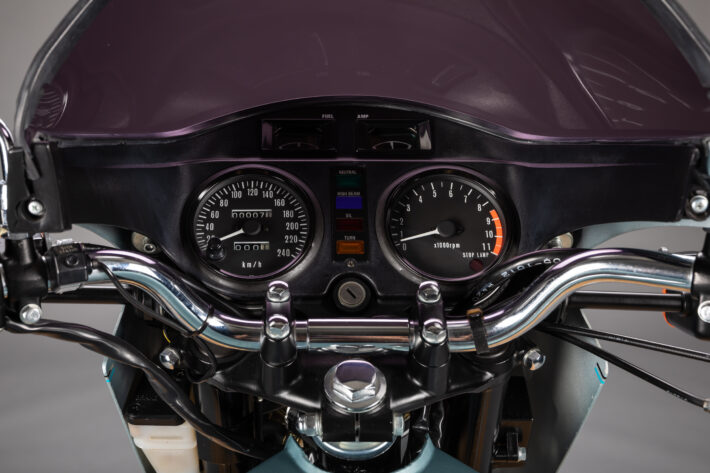
Kawasaki wasn’t content there though. The American importer, Kawasaki Motor Corporation, commissioned a limited production run of 1,000 Z1-Rs fitted with turbochargers. The Ray-Jay turbo systems were designed, supplied and fitted by the American Turbo Pak (ATP) firm, with a 40mm Bendix ‘suck-through’ carburettor replacing the stock four Mikunis.
Compression was left as standard, and there were no other engine internal strengthening mods, which was fine if the turbo pressure was kept to the recommended 6psi. Any mods to produce extra boost and power needed stronger engine internals, like forged pistons, a welded crank and tougher clutch parts to cope. As it was, the Z1-R TC made a crazy 130bhp: utterly wild in the late 1970s, and too much for the tyres, brakes and chassis tech of the time…
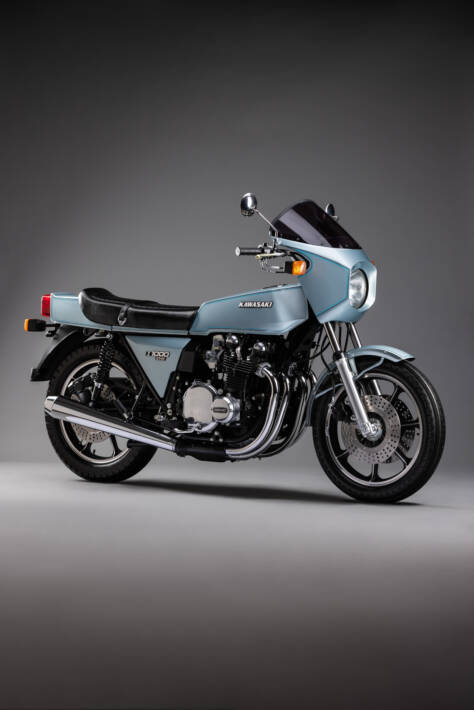
Despite all the performance and tech, the Z1-R and the TC turbo variant weren’t massive sellers in the UK or the US, thanks in part to the high price and improving competition from the other Japanese firms. Now, 45 years later, the Z1-R is a rare bike, especially in good standard original trim, while genuine TC models are like the proverbial hens’ teeth. Expect to pay a lot for either, with good Turbo models now hitting over £30,000 at specialist auctions.
3 GPz1100
At the start of the 1980s, Kawasaki’s unlimited-class air-cooled superbike engine had been bored out to its ultimate capacity of 1,089cc. The 1100 motor would be the last gasp of the old two-valve per cylinder dinosaurs before smaller, more efficient 16-valve water-cooled designs would take over (the GPZ900R was already on the drawing board). But it still had some magic to perform before retirement.
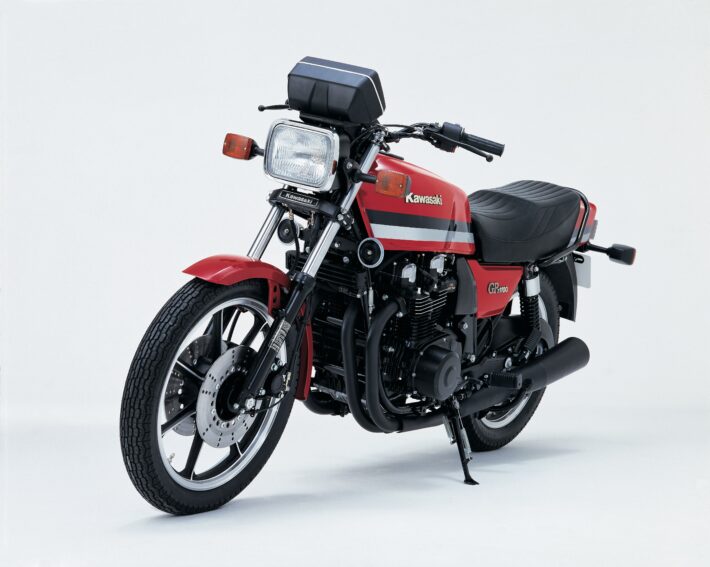
Kawasaki gave its entire sportsbike range a rebranding in 1981-82, adding a ‘GP’ logo to the Z1100, Z750 and Z550 models. Back then, the firm was a strong performer in the 250GP and 350GP classes, winning four world titles with German rider Anton Mang, so the GP branding was well-earned – though the firm’s KR250, 350 and 500 two-stroke GP race bikes had absolutely nothing to do with the four-stroke road bikes.
The first of these new sportsbikes was the Z1100GP B1. It took the standard cradle frame chassis with twin-shock rear suspension from the Z1000, beefed up components where necessary, fitted a modern rectangular headlamp (there was no fairing as yet) and sprinkled some magic tech dust over the electronics. The B1 used the EFI electronic fuel injection from the Z1000H rather than carburettors.
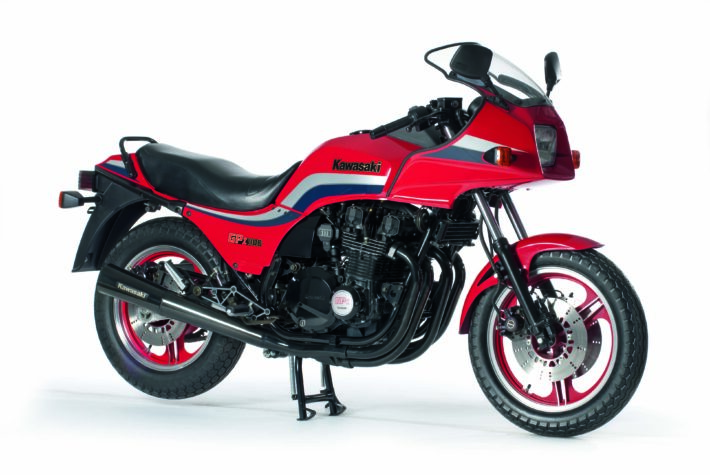
It was an analogue setup, based on the Bosch L-Jetronic car system, with fuelling controlled by transistors and integrated circuits using readouts from analogue resistor sensors, rather than a digital system with a microprocessor, memory, and engine control programming. The engine itself was bored out to 72.5mm from the Z1000’s 70mm, with the same 66mm stroke, and high compression pistons raised the compression to 8.9:1.
The result of all this was a lot of power – 108bhp – and a lot of mass, around 255kg wet. Firecracker Red paint, a black-painted engine, red rear shock springs and gold Kawasaki logos gave stacks of cool style, and the first GPz put Kawasaki back on top of the pile.
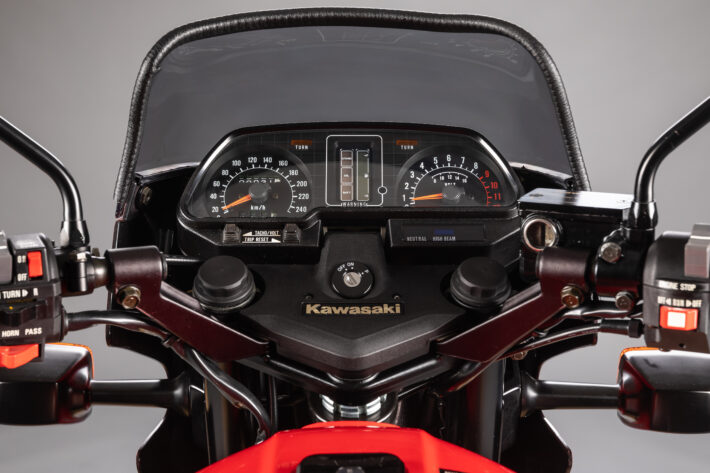
The B1 only lasted a year, though it had shown the way to go. A B2 model in 1982 added a small headlamp fairing, and an all-new digital fuel injection system, with a host of other detail updates.
The big news came in 1983 though, with the last of the heavyweight GPz bruisers, the ZX1100 A1 GPZ1100. It now had a proper monoshock rear suspension, with Uni-Trak rising rate linkage, and a much larger bikini-style half-fairing.
The engine had a final retune, now putting out 120bhp thanks to revised fuel injection, a new bathtub-type combustion chamber and a whole new valvetrain setup with larger intake valves. And Kawasaki came out with fresh innovations like the anti-dive units on the front forks.
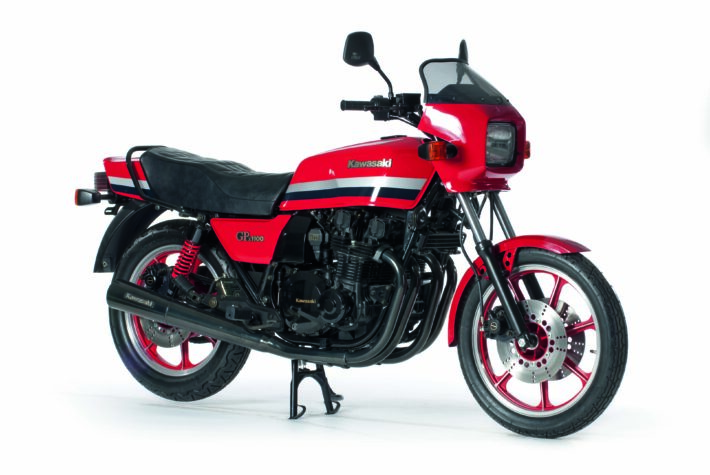
These used hydraulic pressure from the front brake system to lock off part of the compression damping circuit, firming up the damping when you hit the brakes – a bit of a dead end as it turned out, but an interesting idea to try out,
The ZX1100 redesign was a lot of work for a bike whose days were numbered – but the result was a genuinely legendary superbike. Now, GPz1100s of any age are in demand. The first B1s have the advantage of being the original 1100 machine, while the last 1985 ZX1100 A3 variants have much better handling and stronger power. We’d probably go for the ZX model, as the last gasp of a legendary old breed.
4 Z650
Nowadays, the modern Kawasaki Z650 is a neat parallel twin naked roadster, which makes an ideal sporty urban machine, and the same engine powers many a Supertwin race bike on short circuits, Irish road races and the Isle of Man TT and Manx GP, all throughout the season.
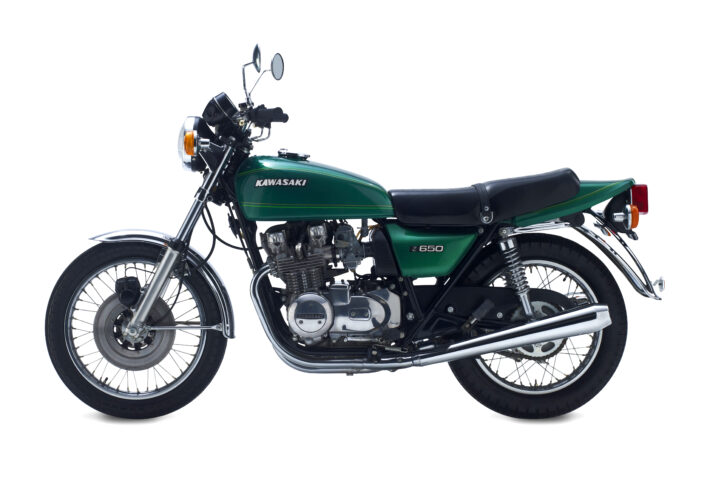
But back in 1976, the new Z650 was nothing less than a mini-Z1, with a smaller overall profile, and a 652cc inline-four DOHC air-cooled engine. The plan was to give ‘750cc performance in a smaller package’, and Kawasaki engineer Ben Inamura – the man behind the Z1 – managed to do just that.
The original Z650 made around 65bhp, weighing in at 211kg dry, and its Z1 roots were clear. The chassis was based on a dual cradle steel tube frame, with dual-shock rear suspension, conventional forks, a single front brake disc and Z1-style tank and tail unit.
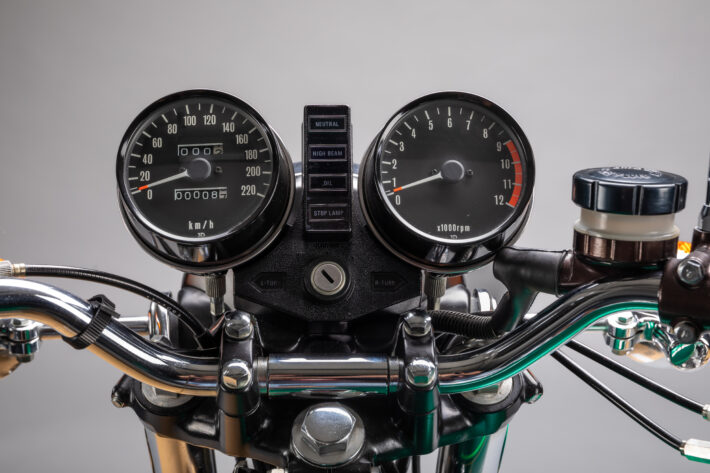
The engine wasn’t just a mini-Z1 though: it had a plain bearing crankshaft and a new bottom end design that used a massive Hyvo primary drive chain and an intermediate jackshaft (this layout would go on to feature in the GPZ900R engine). It also had a redesigned valve train: the adjusting shims moved from sitting on top of the valve ‘buckets’, to locate underneath the bucket.
This gave a much more secure location for the small metal discs at high revs (the Z1 would occasionally spit a shim out from the top of the bucket, causing serious engine damage).
Later updates from 1978-on would add a second front brake disc, uprated suspension parts, a move from wire-spoked to cast wheels, and other subtle styling changes. Kawasaki released an SR variant in 1979, with more of a cruiser style, pullback bars, a 16-inch rear wheel and a unique crossover exhaust design. 1981 would see a move to electronic ignition instead of old-school points, while the kickstarter was finally removed (the Z650 had an electric starter from the beginning, but Kawasaki left the kick lever in place as a backup.)
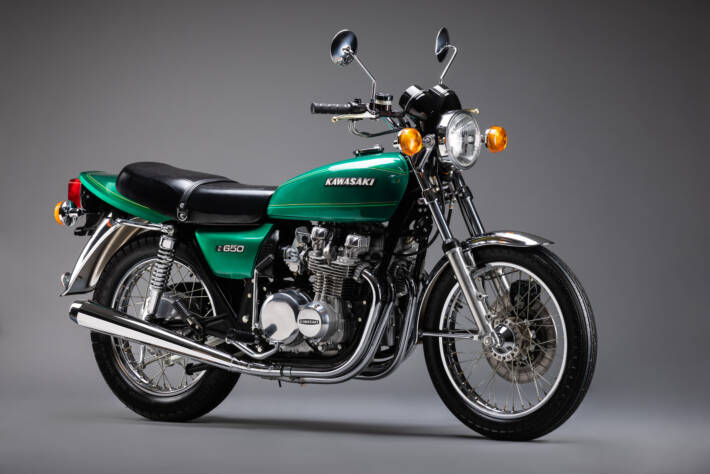
The final version of the Z650, the F3, gained modern 32mm CV carburettors instead of the old round-slide designs, updated GPz switchgear and instruments, and a slightly more angular style to the tank and bodywork.
Nowadays, an original Z650 is a proper retro machine, especially pre-1982 models which are eligible for classic status – no MoT test, road tax or ULEZ charges. As with a Z1, you can make a big difference to the engine and chassis performance with some well-chosen modern upgrades: tyres, shocks, brakes, exhaust and big bore kits. The 652cc motor was used as the basis for the 738cc GPz750, Z750 and 750 Turbo, so the bottom end is man enough to take loads more grunt without any reliability worries.
5 Z750 Turbo
The 1970s were an extremely experimental period for the Japanese firms. It wasn’t totally clear which engine layouts would give the best results, so their engineers had a go at just about everything. That meant big-bore piston-ported two-strokes at the end of the 1960s, then a variety of two-valve four-stroke layouts, twins, triples and fours.
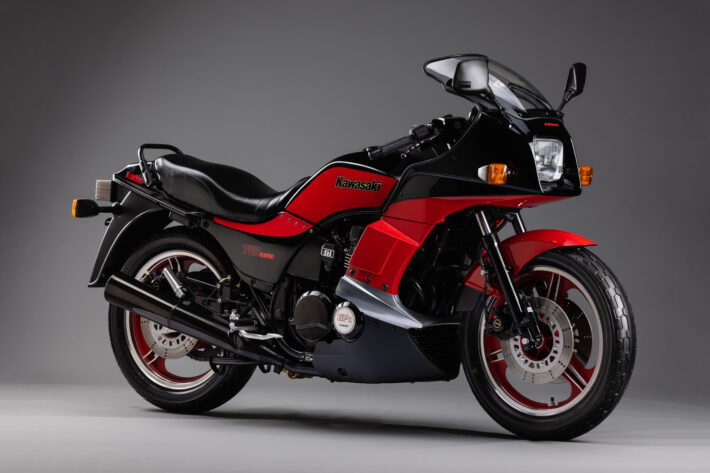
Rotary Wankel engines were given a spin, most notably by Suzuki with its RE-5, then firms tried their hand at advanced two-strokes with water cooling, disc valves, exhaust power valves and reed intake valves, before 16-valve four-stroke fours started to show the way forward.
Turbocharged production bike engines also made an appearance in this decade. The technique of using an exhaust-powered turbine to drive a compressor, pressurising the inlet air charge going into an engine wasn’t new: it had featured in World War II aircraft engines back in the 1940s, and in performance car engines through the 1960s and early 1970s.
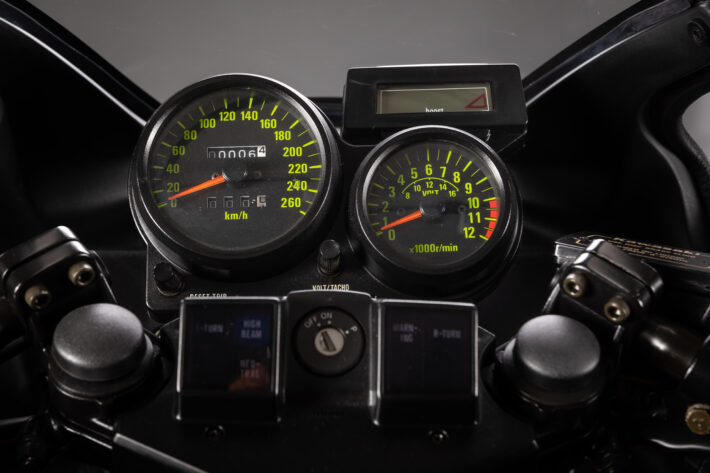
And as a quick and dirty way to boost power outputs, it was very effective: pressurising the intake air means more molecules of oxygen get squeezed into the combustion chamber, add the extra fuel to burn in that oxygen, and you get bigger bangs. It’s like having a bigger capacity engine, without having to build a bigger, heavier motor.
Turbos took a while to appear on bikes: the packaging was a headache, and getting turbochargers to work with smaller engines took some work. Honda, Suzuki and Yamaha all had turbocharged bikes in the 1970s – the CX500/650 Turbo, XN85 and XJ650 Turbo respectively. And Kawasaki America had experimented with a limited production Z1-R TC in 1978.
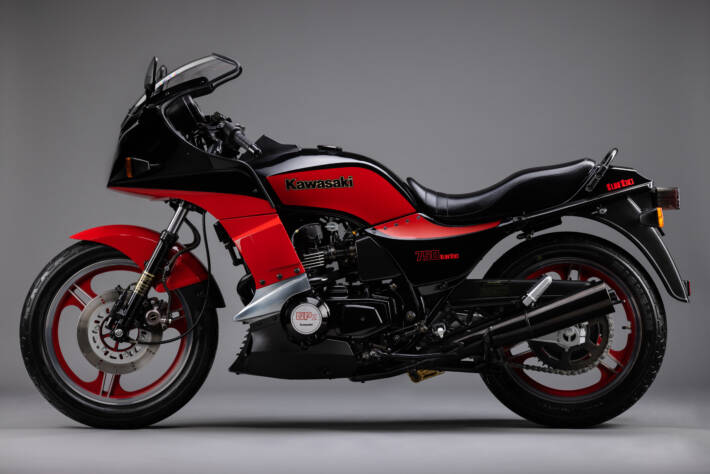
None of these were particularly great though, with limited advantages over normally-aspirated bikes. But Kawasaki made a proper job of the turbo bike when it launched the Z750 Turbo in 1983. It was styled like the GPz750, and many people call it a GPz750 Turbo, though technically it wasn’t a GP model (despite wearing a GPz logo on the crankcase covers…) – but that didn’t matter.
The 738cc engine was based on the Z650 unit, with the larger capacity coming from a 4mm overbore, up to 66mm with the same 54mm bore, and special low-compression pistons that dropped the compression ratio to 7.8:1. A unique super-small Hitachi turbo was mounted on front of the block, close to the exhaust ports, with a special aluminium fairing support in that area, to deal with the massive heat output, and the other engine internals were beefed up – gearbox, sump and lubrication system.
A version of the GPz1100’s DFI digital fuel injection system looked after fuelling, giving a simpler install than turbo engines need with carburettors.
The rest of the bike used GPz750 bodywork and styling, with the addition of an LCD boost gauge – very much the coolest thing to have on a bike in 1983. The chassis was also tweaked, with GPz1100 suspension and brakes, stiffer rear suspension, and slightly more relaxed steering geometry (28° rake instead of 26°).
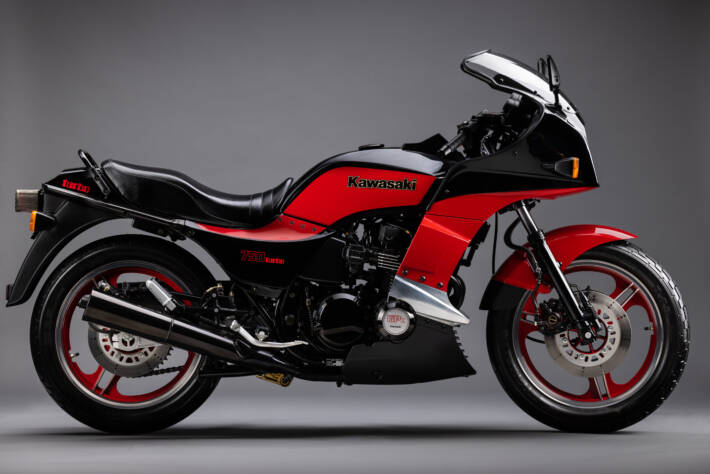
The performance was on par with the GPz1100 and the later GPZ900R – a claimed 112bhp with a dry weight around 233kg, so the only real attraction was the turbo hit and unique powerplant. That was enough for loads of riders though, and the 750 Turbo was by far the most successful of the Japanese turbo bikes of the 1970s and 80s.
Nowadays, a standard, low-mileage 750 Turbo is worth a lot of cash, and even very tired bikes will make good money, either to be broken for parts or used as a base for a full restoration.
6 GPz550
The high-performance middleweight sportsbike didn’t really exist before the GPz550. You had full-bore unlimited superbikes like the Z1, Honda CB750 and Suzuki GS1000, or small-capacity two-stroke sportsters like the Yamaha RD250-400 range or Suzuki’s GT250 X7. In between those were plenty of rather dull standard mid-sized roadsters, but the class which would become the mighty 600cc supersports class was yet to appear.
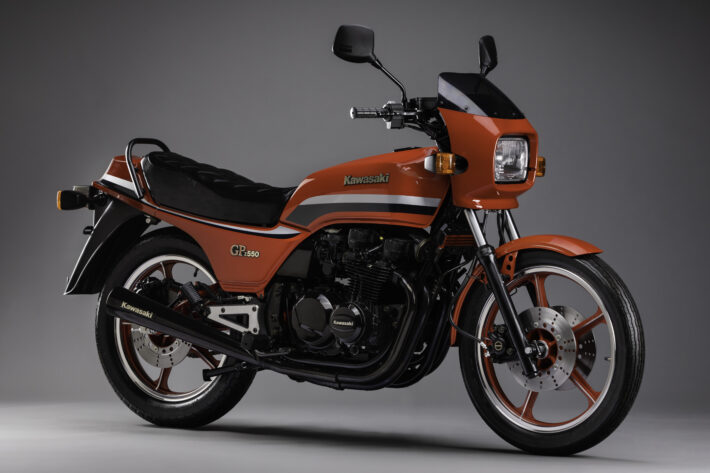
So Kawasaki invented it with the Z550GP D in 1981. Like the 1100 and 750 versions, this started out as a sporty version of a standard roadster, with a small nosecone fairing, twin-shock rear suspension, and a slightly tweaked version of the standard Z550F engine. That 553cc motor was similar in design to the Z650, with a DOHC eight-valve head, four carbs and a six-speed gearbox, making around 54bhp. The 1981 GP version gained extra compression and different carbs, boosting power to 58bhp, in a tweaked chassis with triple disc brakes.
That initial D-model GPz only lasted a year though, and was replaced by a higher-spec H1 version in 1982. That came with the first ever rising-rate monoshock system on a bike – the Uni-Trak rear suspension system. This initial version used a red-painted steel tube swingarm and linkages, operating a single shock behind the engine.
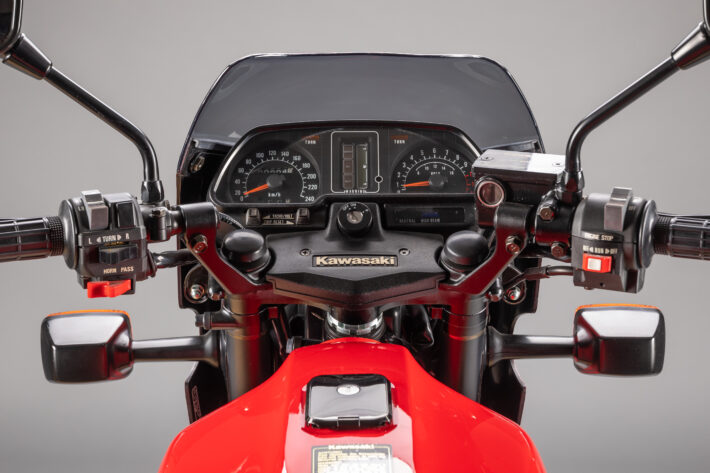
The ultimate GPz550 appeared in 1984 though: the ZX550A1 would use a new aluminium box-section swingarm with alloy linkages, a larger bikini-style half fairing, uprated air forks with anti-dive units and a host of engine mods. It now made 65bhp and weighed in just under 200kg dry, making it a superb performer in its class, easily topping competitors like the Honda CBX550 and Yamaha XJ550.
It was a worthy small-bore rival to the likes of the GPz1100 and new GPZ900R – but would only be in the Kawasaki lineup for a few years. The unstoppable march of progress brought us the GPZ600R in 1985: a 75bhp 16-valve water-cooled engine in a fully-faired sportsbike chassis, which instantly rendered the old two-valve air-cooled GPz550 moot in the same way as the GPZ900R did to the 1100.
7 Z1300
The 1970s might have been rubbish in lots of ways: the three day week, power cuts, strikes, terrorism. But it was a brilliant time for mad motorcycle designs. We had a look at turbos and other unconventional engine layouts in the Z750 Turbo part of this feature – and here’s another piece of pure, untrammelled nonsense from Kawasaki.
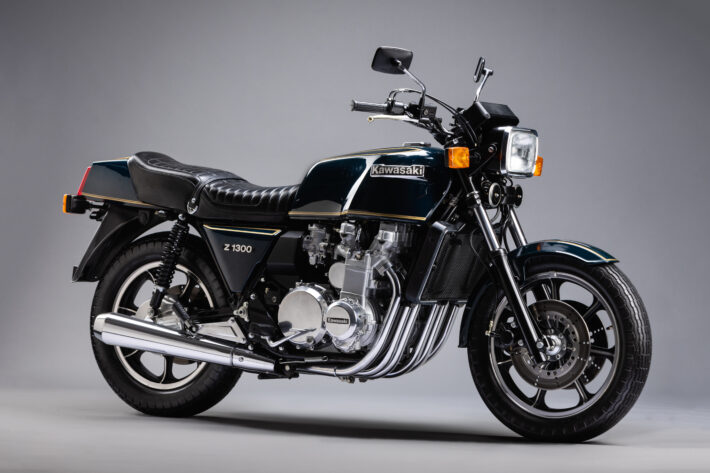
Released in 1978, the Z1300 was designed to take the Z concept to completely new levels of madness. Not content with a 1,000cc class inline-four engine, Kawasaki engineers conceived a new DOHC inline-six motor, with water-cooling, shaft final drive and fuel injection (on later versions). It pushed the boundaries of power, torque, and mass, yet actually turned out to be a very decent, capable machine.
The heart of the matter was of course the 1,286cc motor. An inline-six design is much smoother than a four, and also allows a larger capacity while keeping individual pistons and valves smaller and lighter, improving potential power output. Six-cylinder motors are common in cars, but the problem is keeping them narrow enough for bike use: a hugely wide motor obviously limits cornering.
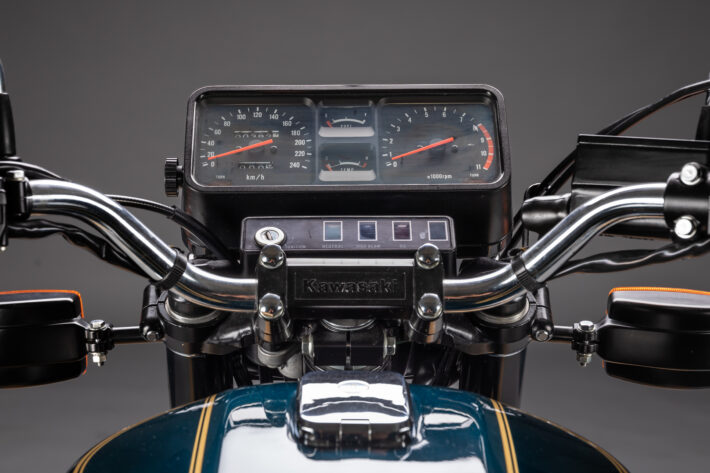
A 62x71mm long-stroke design and water-cooling helped engineers keep the Z1300’s dimensions manageable, and tricks like using three dual-choke carburettors instead of six individual carbs also helped. Power output was a beefy 120bhp, and Kawasaki boasted of the quiet operation (thanks to the water jacket) and smooth running, thanks to the six-cylinder power pulses and a series of shock-absorbing dampers in the drive train.
The Z13 was clearly designed as a tourer, not a sports machine. The sheer mass of the thing ruled that out: it weighed in at 296kg dry, and the steering geometry was suitable relaxed, aimed at stability rather than agility. Suspension was premium kit, with air-assisted forks and rear shocks, with four-way damping adjusters out back, and triple disc brakes helped things slow down fast. As a result, the chassis performance was not at all bad for the late 1970s, and the Z13 could keep up with smaller machines even on twistier roads.
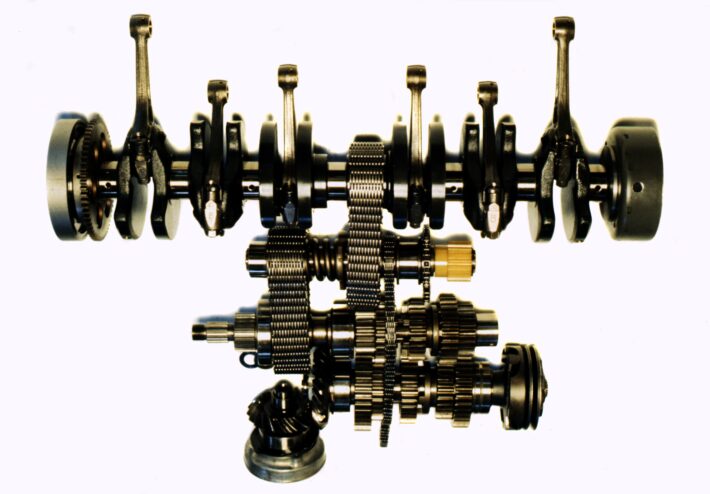
Over the next decade, Kawasaki kept working on the Z1300. It added fuel injection, which gave slightly better mileage, and in the US, the Z13-powered Voyager ultra tourer was launched to take on Honda’s Gold Wing. The Voyager paired the basic engine and chassis package with a massive fairing and hard luggage setup, and featured the highest levels of touring kit: sound system, onboard air compressor for suspension adjustment, extensive dashboard, luxury seating for two, and much more.
Today, more than three decades after production ended, the Z1300 still marks one of the high points of Japanese bike design. It was the last inline-six from the Big Four firms (BMW brought out its K1600 six at the start of the 2010s), and still looks good today. The mass can’t be ignored: there’s no point trying to tune one of these for modern handling prowess, so if you’re lucky enough to own one, we’d keep it largely stock.
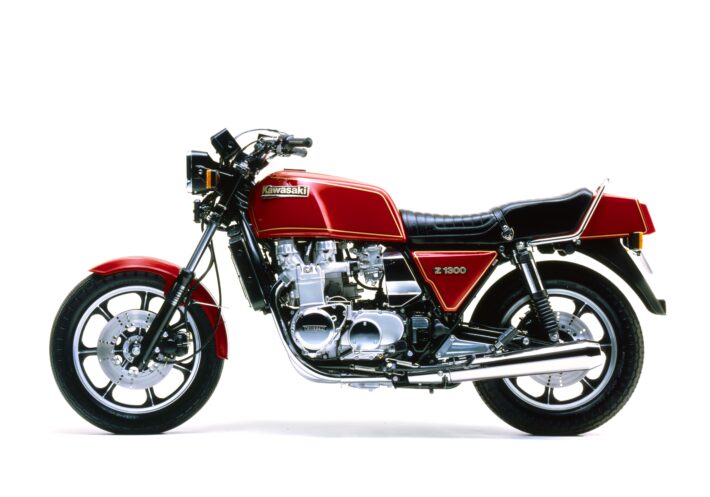
Up-to-date tyres will help matters of course, as will performance brake pads and a suspension tune-up. A subtle exhaust upgrade will release some more of the awesome six-cylinder howl, and let the public know that they’re witnessing one of the finest Japanese machines ever built.
8 Z1100/Spectre
By the late 1980s, Kawasaki was preparing to move on from its original Z bike roots. Air-cooled inline-four engines with two valves per cylinder, double overhead camshafts, four carburettors, five-speed gearboxes and chain final drive had done some amazing things for the firm. But the next generation of water-cooled 16-valve motors were on the way, and the 1984 GPZ900R would deliver the same revolution in performance that the Z1 had delivered in 1972.
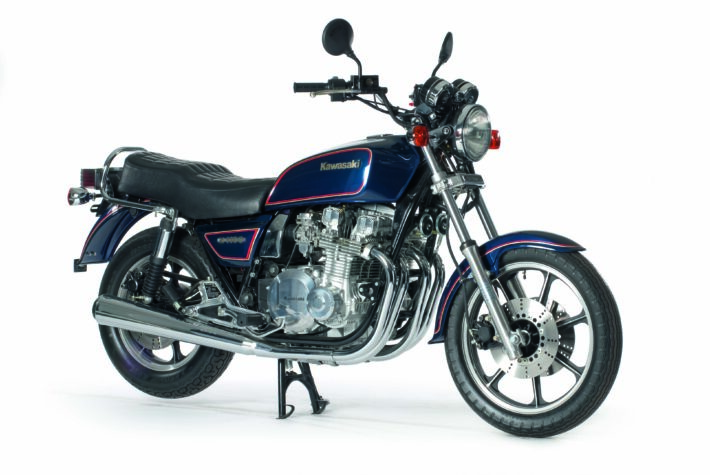
But there was still potential life in the old dog as the 70s came to an end. The GPz1100 had taken the Z1-based engine out to 1,089cc, tuned it for peak power, and put it into a pure sportsbike chassis. That was fine for many riders – but Kawasaki also offered a less sporty full-bore option: the Z1100 and Spectre. Both of these bikes used the same powerplant, based on the Z1000 ST shaft drive unit from 1979.
A 3.1mm overbore from 69.4mm to 72.5mm, with the same 66mm stroke, took capacity from 1,015cc to 1,089cc. That, together with more compression and a switch to larger 34mm CV carbs gave a six or seven bhp peak power increase, and lots more torque in the midrange.
The basic Z1100 A was a naked touring machine, with rubber engine mounts reducing vibration, and lower gearing giving good acceleration and improved flexibility. The shaft drive and electronic ignition reduced maintenance requirements, and air-assisted suspension improved handling and adjustability for two-up work.
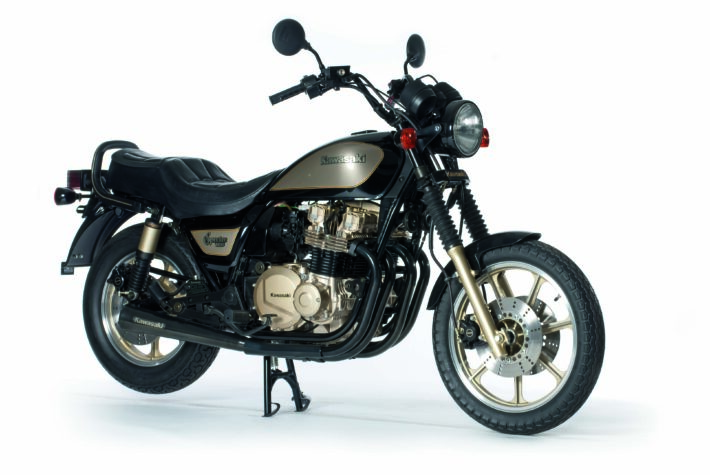
The Spectre was a US-focused custom variant of the Z1100A. It kept the same basic engine and chassis package, but with a heavy hot-rod makeover. The riding position was changed with a new king and queen dual seat, and high pullback bars. A narrower front wheel and altered steering geometry gave a sharper look to the front end, and a smaller peanut-style fuel tank rounds off the restyle.
A premium black and gold paint job extended to the engine and wheels and even the rear shock absorbers were finished in a deep bronzed gold. Fork and shock gaiters protected the suspension units, and a black chrome four-into-two exhaust system boosted midrange grunt. The gothic-script ‘Spectre’ sidepanel logo is the icing on the heavy-metal cake.
The Z1100 models weren’t massive sellers, and were only on sale for a few years, so are very rare in the UK nowadays. If you do find one – perhaps a US import – then it could make a super-unusual classic retro roadster, with some real old-school muscle behind it.
9 Z1000H/R/ST
The first Z1000 A1 was launched in 1976 as a straight update on the original Z900/Z1, with the engine bored out to 1,015cc thanks to a 69.4mm bore, triple disc brakes, a four-into-two exhaust and uprated equipment. Power was now 83bhp, with more midrange, but not much in the way of extra top speed, partly because of gearing and partly because Kawasaki had fitted smaller 26mm carburettors.
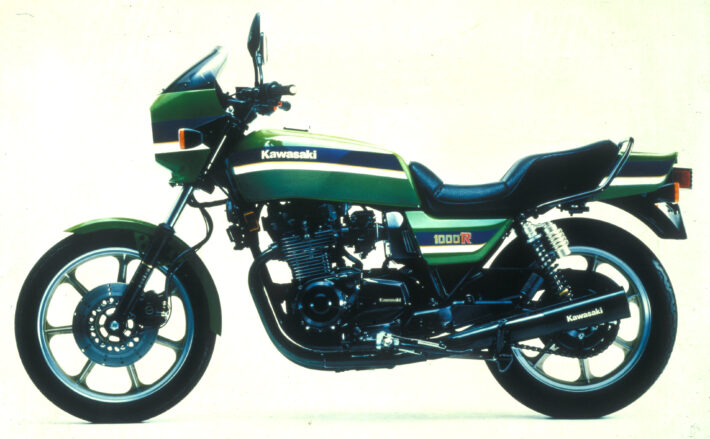
It fixed that in ‘78 with the Z1-R and its 28mm carbs, and by 1979 the Z1000 was the base for a range of capable machinery. The ST variant added a shaft drive for extra touring abilities, removing the handicap of chain maintenance (though around this time Kawasaki was fitting early O-ring chains which massively improved the situation).
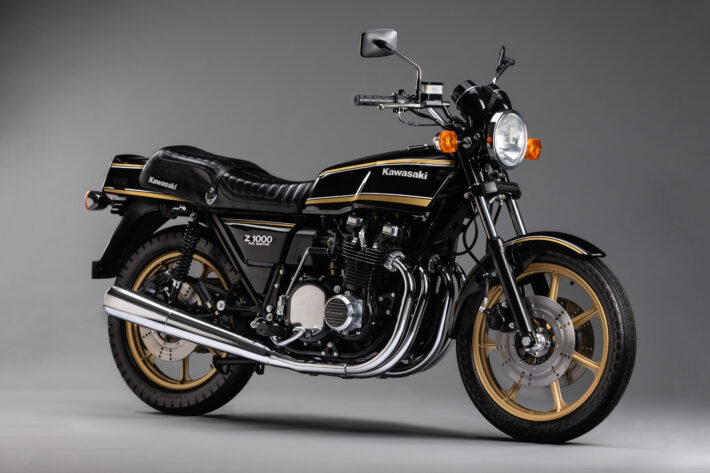
Tubeless tyres made an appearance too, alongside a fuel gauge, a bigger 18 litre fuel tank and uprated suspension. Add on luggage and an aftermarket fairing, which were starting to become widely available, and you had the base for a strong, capable distance touring machine.
The next leap forward for the Z1000 was the 1980 H model, which was the first production motorcycle to use fuel injection instead of carburettors. That early setup used an analogue system, based on the Bosch Jetronic design, rather than the later digital fuel injection, and had injectors mounted in each intake port.
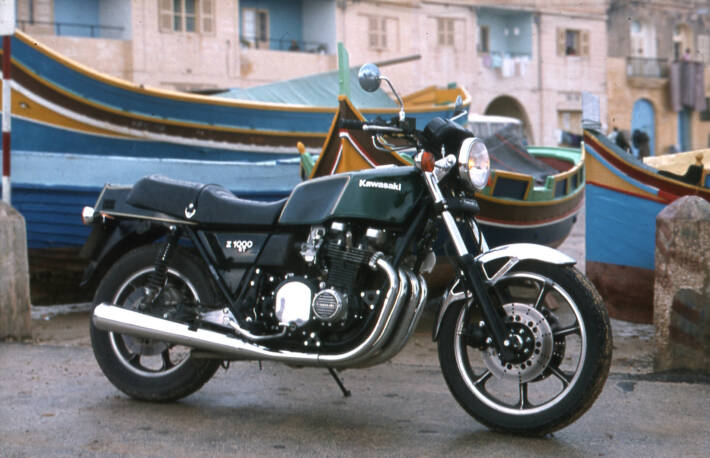
It worked well, despite technophobic worries from the conservative side of the biking community, though needed to have a battery in good charge to work flawlessly. That explains the seemingly anachronistic kickstart on the right hand side of the engine, kept in place to act as a backup when the battery output dropped too much…
The final stage of the Z1000 development was a bit special. In America, the AMA Superbike race series had caught the imagination of the people, with its 1,000cc production-based class. There, the likes of Reg Pridmore, Wes Cooley, Freddie Spencer and Eddie Lawson made their names, wrestling tuned versions of big four-cylinder superbikes round the racetracks of the United States. Kawasaki won the title in 1977 and 78 with British racer Pridmore riding, and Lawson would win in 1981 and 82, all on heavily-modified Z1000 and Z1100-based bikes.
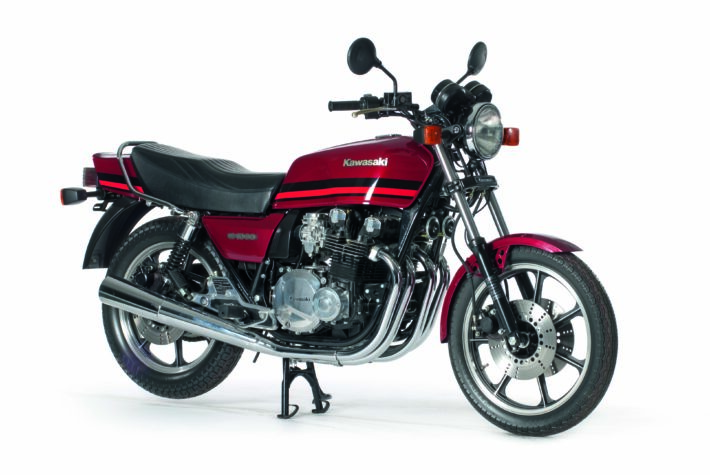
Kawasaki capitalised on this success with the limited edition Z1000R Eddie Lawson replica in 1982-83. It came with a special 998cc engine with Kerker four-into-one black chrome performance exhaust and an oil cooler, GPz style fairing, uprated rear shocks and forks with stiffer springing and damping and tweaked steering geometry. Tubeless Dunlop tyres and a wider rear rim rounded off the upgrades. 1984 brought an 1100 version, with more capacity and extra power, now making 120bhp, the same as the GPz1100.
All versions of the Z1000/1100 R are very rare and super-valuable now – though there are lots of replicas out there, so check carefully before shelling out big money.
10 GPz750 GT750 Z750
If you’re fairly new to motorbikes, then 750cc is a bit of a niche capacity. There’s Honda’s NC750 twin range, BMW’s F750 (which is actually an 853cc twin…) and the Suzuki GSX-S750, which used the old GSX-R750 motor, and that’s pretty much it in terms of new bikes in 2022.
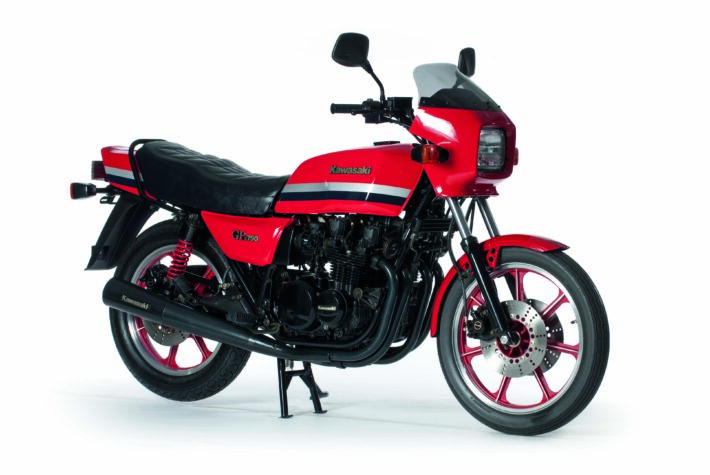
But back in the late 1970s, the 750s were coming into their own. The litre class bikes had an obvious power advantage, but were too heavy for fine handling, and the three-quarter litre sector would soon take over as the premier production racing class. By the late 1980s, the Honda RC30, Yamaha OW01, Suzuki GSX-R750 and Kawasaki ZX-7R would all be at the pinnacle of world superbike racing, bringing incredible performance and handling.
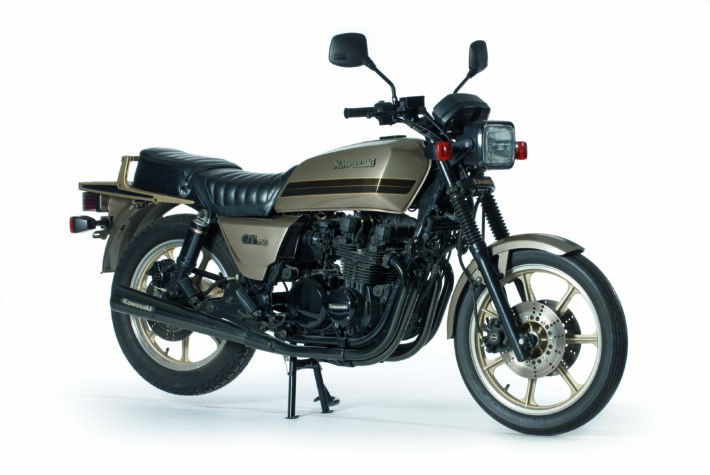
We need to rewind a little first though. In the second half of the 1970s, Honda’s CB750 and Suzuki GS750 were taking on Kawasaki’s Z650 in the light heavyweight roadster class. The Z650 had been designed to give 750 performance, but really needed more cubes to match the competition.
A rebore to 738cc in 1979 thanks to 4mm bigger pistons gave the Z750FX – a full 750 roadster version of the 650 (there had also been an earlier 750 version of the Z1, available only in Japan, which was a totally different beast). This new 750 four made 74bhp, in a standard roadster chassis.
The big deal was the GPz750 though. Like the rest of that family, it started out in 1981 as a variant of the naked roadster with sharper 78bhp engine and chassis setup, and a small headlamp fairing.
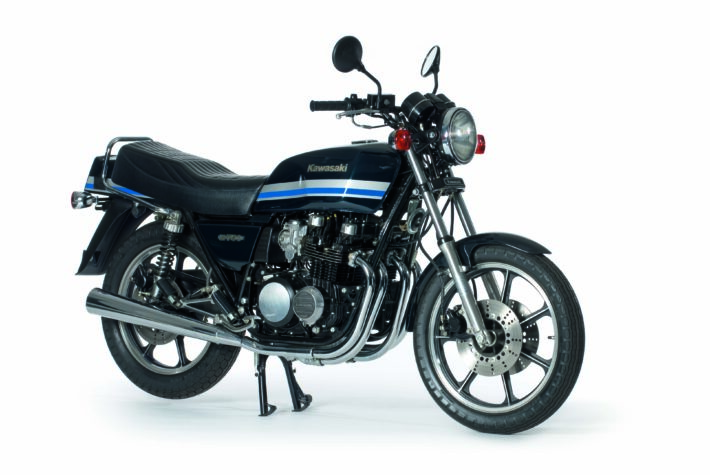
But it was the 1983 ZX750 version that really moved things on, and is arguably the first proper 750 sportsbike, a couple of years before the Suzuki GSX-R750. It put a tuned 87bhp version of that 738cc motor in a chassis that was similar to the ZX versions of the GPz1100 and GPz550 of the same era. With Kawasaki’s Uni-Trak rear monoshock suspension, half-fairing, and LCD display for fuel and error warnings, it was a high-end machine – but was overshadowed a bit by the rest of the family.
The GPz550 was nearly as quick in a smaller package, the 1100 stomped all over it in terms of power, and the 750 Turbo version was ten times as cool. The GPz hadn’t taken the 750cc class forward in terms of potential that the GSX-R750 would make a couple of years later, but it had led the way.
The final member of the 1980s Z750 family was the 1982 GT750 – a pure touring variant, with a 78bhp tune, shaft final drive, fork gaiters, super-comfy seat with standard luggage rack, huge 24 litre fuel tank, air suspension, and the potential for a lot of miles. It became the long-distance despatch rider’s tool of choice, despite not having a standard fairing, and the market for aftermarket bodywork and windscreens exploded in the UK in particular.
Like many everyday cars of the era, most GT750s had a hard life, and were scrapped when worn out. As a result, a good-condition GT750 is arguably rarer than something like a GPz or Turbo 750, simply because they’re not seen as worth keeping in good order, or restoring to good stock condition. Parts like the black chrome exhausts are impossible to find in good standard order, and a nice GT is now a very unusual sight on the road, sadly!
3 comments on “Top Ten Kawasaki Z bikes from the 1970s and 80s”
I absolutely adore my kz1100 spectre…. although all tube is now black not chrome or gold.
and my run-about a kz440c
both 1982
I used to ride mine for getting people through their test…. I quit on health problems but had put over 400 through old standard test on 125s and mopeds… I could follow in comfort all day… thats over 400 1st time pass and under 2nd time
Then I put over 100 through direct access 1st time and 3 fails… 2 2nd time and one woman 4th time… she could ride well and easily up to standard but always started on test (never elsewhere) with the side stand down……… cured on 4th test… I took the stand off.
I saw 1978 Z1R out side a house as I went school at age 16 & thought 1 day I’ll get one & in 2001 I bought one ! Still garage now !! Puts a smile on my face still
Nice piece on the old Zds. I still have my 1983 z1000 and a Gpz 900r, love them both. Really like the like the old colours that Kawasaki have used on this years bikes.